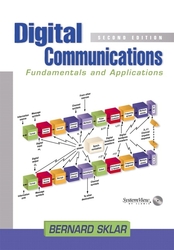Error Correcting Coding and Security for Data Networks: Analysis of the Superchannel Concept (Hardcover)
暫譯: 數據網絡的錯誤更正編碼與安全性:超通道概念分析 (精裝本)
Grigorii Kabatiansky, Evgenii Krouk, Sergei Semenov
買這商品的人也買了...
-
 微軟開發快速秘笈 (Rapid Development)
微軟開發快速秘笈 (Rapid Development)$600$600 -
 Microsoft Office 2000 Web Components 程式設計開發指南
Microsoft Office 2000 Web Components 程式設計開發指南$600$600 -
 $1,078Perl How to Program (IE-Paperback)
$1,078Perl How to Program (IE-Paperback) -
 C# 語言實務
C# 語言實務$600$600 -
 PostgreSQL 實務應用
PostgreSQL 實務應用$420$328 -
 SQL 基礎講座
SQL 基礎講座$290$226 -
 Perl 學習手札
Perl 學習手札$390$332 -
 Head First Design Patterns (Paperback)
Head First Design Patterns (Paperback)$2,510$2,385 -
 ASP.NET 徹底研究進階技巧─高階技巧與控制項實作
ASP.NET 徹底研究進階技巧─高階技巧與控制項實作$650$507 -
 UML 精華第三版 : 標準物件模型語言 (UML Distilled, 3/e)
UML 精華第三版 : 標準物件模型語言 (UML Distilled, 3/e)$460$363 -
 Linux Device Drivers, 3/e (Paperback)
Linux Device Drivers, 3/e (Paperback)$1,881$1,782 -
 Excel VBA 功能索引式參考手冊
Excel VBA 功能索引式參考手冊$550$468 -
 $1,615CCNA Cisco Certified Network Associate Study Guide, 5/e (640-801)
$1,615CCNA Cisco Certified Network Associate Study Guide, 5/e (640-801) -
 Linux iptables 技術實務─防火牆、頻寬管理、連線管制
Linux iptables 技術實務─防火牆、頻寬管理、連線管制$620$527 -
 知識管理理論與實務, 2/e
知識管理理論與實務, 2/e$350$315 -
 CCNA 認證教戰手冊 (CCNA: Cisco Certified Network Associate Study Guide, 5/e)(Exam 640-801)
CCNA 認證教戰手冊 (CCNA: Cisco Certified Network Associate Study Guide, 5/e)(Exam 640-801)$820$697 -
 Fedora Core 4 Linux 安裝與系統管理 (DVD版)
Fedora Core 4 Linux 安裝與系統管理 (DVD版)$580$458 -
 Fedora Core 4 Linux 安裝與系統管理
Fedora Core 4 Linux 安裝與系統管理$580$458 -
 Statistical Methods in Bioinformatics: An Introduction, 2/e (Hardcover)
Statistical Methods in Bioinformatics: An Introduction, 2/e (Hardcover)$5,680$5,396 -
 $1,127Database System Concepts, 5/e (IE) (美國版ISBN:0072958863)
$1,127Database System Concepts, 5/e (IE) (美國版ISBN:0072958863) -
 Applied Bayesian Modelling (Hardcover)
Applied Bayesian Modelling (Hardcover)$1,700$1,666 -
 FrontPage 2003: The Missing Manual
FrontPage 2003: The Missing Manual$1,250$1,188 -
 Sams Teach Yourself Visual C# 2005 in 24 Hours, Complete Starter Kit
Sams Teach Yourself Visual C# 2005 in 24 Hours, Complete Starter Kit$1,680$1,596 -
 免費!合法!超 Easy OpenOffice.org2
免費!合法!超 Easy OpenOffice.org2$350$298 -
 $1,068Detection and Estimation Theory: and Its Applications (Paperback)
$1,068Detection and Estimation Theory: and Its Applications (Paperback)
商品描述
Description:
- Discusses the problem of reconciling coding applied to different layers using a superchannel approach
- Includes thorough coverage of all the key codes: linear block codes, Hamming, BCH and Reed-Solomon codes, LDPC codes decoding, as well as convolutional, turbo and iterative coding
- Considers new areas of application of error correcting codes such as transport coding, code-based cryptosystems and coding for image compression
- Demonstrates how to use error correcting coding to control such important data characteristics as mean message delay
- Provides theoretical explanations backed up by numerous real-world examples and practical recommendations
- Features a companion website containing additional research results including new constructions of LDPC codes, joint error-control coding and synchronization, Reed-Muller codes and their list decoding
By progressing from theory through to practical problem solving, this resource contains invaluable advice for researchers, postgraduate students, engineers and computer scientists interested in data communications and applications of coding theory.
Table of Contents:
Preface.
1 Problems Facing Error Control Coding in Data Networks.
1.1 International Recommendations on Using Error Control Coding at Different Network Layers.
1.2 Classification of Problems on Coding in Networks.
2 Block Codes.
2.1 Main Definitions.
2.2 Algebraic Structures.
2.3 Linear Block Codes.
2.4 Cyclic Codes.
2.5 Bounds on Minimum Distance.
3 General Methods of Decoding of Linear Codes.
3.1 Minimum Distance Decoding.
3.2 Information Set Decoding.
3.3 A Supercode Decoding Algorithm.
3.4 The Complexity of Decoding in the Channel with Independent Errors.
4 Codes with Algebraic Decoding.
4.1 Hamming Codes.
4.2 Reed-Solomon Codes.
4.3 BCH Codes.
4.4 Decoding of BCH Codes.
4.5 The Sudan Algorithm and its Extensions.
5 Decoding of LDPC Codes.
5.1 Low-Density Parity-Check Codes.
5.2 LDPC Constructions.
5.3 Estimating the Minimum Distance of EG-LDPC Codes.
5.4 Burst-Error-Correcting LDPC Codes.
5.5 Decoding Schemes of LDPC Codes.
5.6 Simulation Results in AWGN.
Appendix 5.A Euclidean Geometries.
6 Convolutional Codes and Turbo-Codes.
6.1 Convolutional Codes Representation and Encoding.
6.2 Viterbi Decoding Algorithm.
6.3 List Decoding.
6.4 Sequential Decoding.
6.5 Parallel-Concatenated Convolutional Codes and Soft Input Soft Output Decoding.
6.6 SISO Decoding Algorithms.
7 Coding of Messages at the Transport Layer of the Data Network.
7.1 Decreasing the Message Delay with the help of Transport Coding.
7.2 Transmission of Message during Limited Time.
7.3 Transmission of Priority Messages without using Priority Packets .
7.4 Estimation of the Effectiveness of Transport Coding for the Nonexponential Model of Packet Delay.
8 Providing Security of Data in a Network with the Help of Coding Methods.
8.1 Public-Key Cryptography.
8.2 Codebased Cryptosystems: McEliece and Niederreiter.
8.3 Cryptosystems Based on Full Decoding.
8.4 Further Development of Codebased Cryptosystems.
8.5 Codebased Cryptosystems and RSA: Comparison and Perspectives.
8.6 Codebased Signature.
9 Reconciliation of Coding at Different Layers of a Network.
9.1 Transport Coding in a Network with Unreliable Channels.
9.2 Reconciliation of Channel and Transport Coding.
9.3 Use of Tornado Codes for Reconciliation of Channel and Transport Coding.
9.4 Development of Coding Methods at the Presentation Layer.
9.5 Reconciliation of Coding at Neighbour Layers of a Network.
Index.
商品描述(中文翻譯)
**描述:**
錯誤更正編碼通常是根據其在數據網絡中各個層級的應用進行分析,這些層級彼此獨立。在這種全新的方法中,作者將數據網絡視為一個**超通道**(一個多層次的實體),這使得錯誤更正編碼能夠在整體上評估其在多個網絡層中的應用。通過揭示在數據網絡中應用錯誤更正編碼的問題,並討論編碼理論及其應用,這一原創技術展示了如何通過在不同網絡層進行**聯合**編碼來修正網絡中的錯誤。
- 討論使用超通道方法調和應用於不同層的編碼問題
- 包含所有關鍵編碼的全面覆蓋:線性區塊編碼、Hamming編碼、BCH編碼和Reed-Solomon編碼、LDPC編碼解碼,以及卷積編碼、Turbo編碼和迭代編碼
- 考慮錯誤更正編碼的新應用領域,如傳輸編碼、基於編碼的密碼系統和圖像壓縮編碼
- 演示如何使用錯誤更正編碼來控制重要的數據特徵,如平均消息延遲
- 提供理論解釋,並附有眾多現實世界的例子和實用建議
- 特別提供一個伴隨網站,包含額外的研究結果,包括新的LDPC編碼構造、聯合錯誤控制編碼和同步、Reed-Muller編碼及其列表解碼
通過從理論到實際問題解決的進展,這本資源為對數據通信和編碼理論應用感興趣的研究人員、研究生、工程師和計算機科學家提供了寶貴的建議。
**目錄:**
前言。
**1 數據網絡中錯誤控制編碼面臨的問題。**
1.1 在不同網絡層使用錯誤控制編碼的國際建議。
1.2 網絡中編碼問題的分類。
**2 區塊編碼。**
2.1 主要定義。
2.2 代數結構。
2.3 線性區塊編碼。
2.4 循環編碼。
2.5 最小距離的界限。
**3 線性編碼的一般解碼方法。**
3.1 最小距離解碼。
3.2 信息集解碼。
3.3 超碼解碼算法。
3.4 在獨立錯誤通道中的解碼複雜性。
**4 具有代數解碼的編碼。**
4.1 Hamming編碼。
4.2 Reed-Solomon編碼。
4.3 BCH編碼。
4.4 BCH編碼的解碼。
4.5 Sudan算法及其擴展。
**5 LDPC編碼的解碼。**
5.1 低密度奇偶檢查編碼。
5.2 LDPC構造。
5.3 EG-LDPC編碼的最小距離估計。
5.4 突發錯誤更正的LDPC編碼。
5.5 LDPC編碼的解碼方案。
5.6 AWGN中的模擬結果。
附錄 5.A 歐幾里得幾何。
**6 卷積編碼和Turbo編碼。**
6.1 卷積編碼的表示和編碼。
6.2 Viterbi解碼算法。
6.3 列表解碼。
6.4 順序解碼。
6.5 並行串聯卷積編碼和軟輸入軟輸出解碼。
6.6 SISO解碼算法。
**7 數據網絡傳輸層的消息編碼。**
7.1 通過傳輸編碼減少消息延遲。
7.2 在有限時間內傳輸消息。
7.3 在不使用優先數據包的情況下傳輸優先消息。
7.4 對非指數模型的數據包延遲的傳輸編碼有效性進行估計。
**8 通過編碼方法提供網絡數據的安全性。**
8.1 公鑰密碼學。
8.2 基於編碼的密碼系統:McEliece和Niederreiter。
8.3 基於完全解碼的密碼系統。
8.4 基於編碼的密碼系統的進一步發展。
8.5 基於編碼的密碼系統與RSA的比較及前景。
8.6 基於編碼的簽名。
**9 網絡中不同層的編碼調和。**
9.1 在不可靠通道中的傳輸編碼。
9.2 通道和傳輸編碼的調和。
9.3 使用龍捲風編碼調和通道和傳輸編碼。
9.4 在表示層發展編碼方法。
9.5 網絡相鄰層的編碼調和。
索引。










